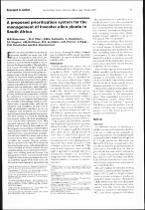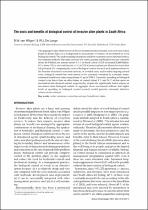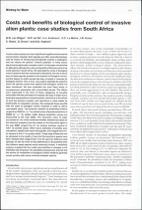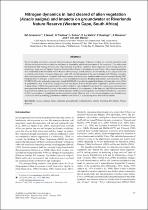 ResearchSpace
ResearchSpace
Proposed prioritization system for the management of invasive alien plants in South Africa
JavaScript is disabled for your browser. Some features of this site may not work without it.
- ResearchSpace
- →
- Research Publications/Outputs
- →
- Journal Articles
- →
- View Item
| dc.contributor.author |
Robertson, MP

|
en_US |
| dc.contributor.author |
Villet, MH

|
en_US |
| dc.contributor.author |
Fairbanks, DHK

|
en_US |
| dc.contributor.author |
Henderson, L

|
en_US |
| dc.contributor.author |
Higgins, SI

|
en_US |
| dc.contributor.author |
Hoffmann, JH

|
en_US |
| dc.contributor.author |
Le Maitre, David C

|
en_US |
| dc.contributor.author |
Palmer, AR

|
en_US |
| dc.contributor.author |
Riggs, I

|
en_US |
| dc.contributor.author |
Shackleton, CM

|
en_US |
| dc.contributor.author |
Zimmermann, HG

|
en_US |
| dc.date.accessioned | 2007-03-27T10:07:00Z | en_US |
| dc.date.accessioned | 2007-06-07T10:07:19Z | |
| dc.date.available | 2007-03-27T10:07:00Z | en_US |
| dc.date.available | 2007-06-07T10:07:19Z | |
| dc.date.issued | 2003-01 | en_US |
| dc.identifier.citation | Robertson, MP, et al. 2003. Proposed prioritization system for the management of invasive alien plants in South Africa. South African Journal of Science, vol. 99, 02 March, pp 37-43 | en_US |
| dc.identifier.issn | 0038-2353 | en_US |
| dc.identifier.uri | http://hdl.handle.net/10204/2098 | en_US |
| dc.identifier.uri | http://hdl.handle.net/10204/2098 | |
| dc.description.abstract | Every country has weed species whose presence conflicts in some way with human management objectives and needs. Resources for research and control are limited, so priority should be given to species that are the biggest problem. The prioritization system described in this article was designed to assess objectively research and control priorities of invasive alien plants at a national scale in South Africa. The evaluation consists of seventeen criteria, grouped into five modules that assess invasiveness, spatial characteristics, potential impact, potential for control, and conflicts of interest for each plant species under consideration. Total prioritization scores, calculated from criterion and module scores, were used to assess a species' priority. Prioritization scores were calculated by combining independent assessments provided by several experts, thus increasing the reliability of the rankings. The total confidence score, a separate index, indicates the reliability and availability of data used to make an assessment. Candidate species for evaluation were identified and assessed by several experts using the prioritization system. The final ranking was made by combining two separate indices, the total prioritization score and the total confidence score. This approach integrates the plant's perceived priority with an index of data reliability. Of the 61 species assessed, those with the highest ranks (Lantana camara, Chromolaena odorata and Opuntia ficus-indica) had high prioritization and high confidence scores, and are thus of most concern. Those species with the lowest ranks, for example, Harrisia martinii, Opuntia spinulifera and Opuntia exaltata, had low prioritization scores and high confidence scores, and thus are of least concern. The authors approach to ranking weeds offers several advantages over existing systems because it is designed for multiple assessors based on the Delphi decision-making technique, the criteria contribute equally to the total score, and the system can accommodate incomplete data on a species. Although the choice of criteria may be criticized and the system has certain limitations, it appears to have delivered credible results. | en_US |
| dc.format.extent | 1931541 bytes | en_US |
| dc.format.mimetype | application/pdf | en_US |
| dc.language.iso | en | en_US |
| dc.publisher | Academy of Science of South Africa | en_US |
| dc.rights | Copyright: 2003 Academy of Science of South Africa | en_US |
| dc.subject | Invasive alien plants | en_US |
| dc.subject | Plants management | en_US |
| dc.subject | Prioritization system | en_US |
| dc.subject | Invasive alien plants | en_US |
| dc.subject | Alien plants spatial characteristics | en_US |
| dc.subject | Alien plants potential impact | en_US |
| dc.subject | Control potential of alien plants | en_US |
| dc.subject | Alien plants conflicts | en_US |
| dc.subject | Multidisciplinary sciences | en_US |
| dc.title | Proposed prioritization system for the management of invasive alien plants in South Africa | en_US |
| dc.type | Article | en_US |
| dc.identifier.apacitation | Robertson, M., Villet, M., Fairbanks, D., Henderson, L., Higgins, S., Hoffmann, J., ... Zimmermann, H. (2003). Proposed prioritization system for the management of invasive alien plants in South Africa. http://hdl.handle.net/10204/2098 | en_ZA |
| dc.identifier.chicagocitation | Robertson, MP, MH Villet, DHK Fairbanks, L Henderson, SI Higgins, JH Hoffmann, David C Le Maitre, et al "Proposed prioritization system for the management of invasive alien plants in South Africa." (2003) http://hdl.handle.net/10204/2098 | en_ZA |
| dc.identifier.vancouvercitation | Robertson M, Villet M, Fairbanks D, Henderson L, Higgins S, Hoffmann J, et al. Proposed prioritization system for the management of invasive alien plants in South Africa. 2003; http://hdl.handle.net/10204/2098. | en_ZA |
| dc.identifier.ris | TY - Article AU - Robertson, MP AU - Villet, MH AU - Fairbanks, DHK AU - Henderson, L AU - Higgins, SI AU - Hoffmann, JH AU - Le Maitre, David C AU - Palmer, AR AU - Riggs, I AU - Shackleton, CM AU - Zimmermann, HG AB - Every country has weed species whose presence conflicts in some way with human management objectives and needs. Resources for research and control are limited, so priority should be given to species that are the biggest problem. The prioritization system described in this article was designed to assess objectively research and control priorities of invasive alien plants at a national scale in South Africa. The evaluation consists of seventeen criteria, grouped into five modules that assess invasiveness, spatial characteristics, potential impact, potential for control, and conflicts of interest for each plant species under consideration. Total prioritization scores, calculated from criterion and module scores, were used to assess a species' priority. Prioritization scores were calculated by combining independent assessments provided by several experts, thus increasing the reliability of the rankings. The total confidence score, a separate index, indicates the reliability and availability of data used to make an assessment. Candidate species for evaluation were identified and assessed by several experts using the prioritization system. The final ranking was made by combining two separate indices, the total prioritization score and the total confidence score. This approach integrates the plant's perceived priority with an index of data reliability. Of the 61 species assessed, those with the highest ranks (Lantana camara, Chromolaena odorata and Opuntia ficus-indica) had high prioritization and high confidence scores, and are thus of most concern. Those species with the lowest ranks, for example, Harrisia martinii, Opuntia spinulifera and Opuntia exaltata, had low prioritization scores and high confidence scores, and thus are of least concern. The authors approach to ranking weeds offers several advantages over existing systems because it is designed for multiple assessors based on the Delphi decision-making technique, the criteria contribute equally to the total score, and the system can accommodate incomplete data on a species. Although the choice of criteria may be criticized and the system has certain limitations, it appears to have delivered credible results. DA - 2003-01 DB - ResearchSpace DP - CSIR KW - Invasive alien plants KW - Plants management KW - Prioritization system KW - Invasive alien plants KW - Alien plants spatial characteristics KW - Alien plants potential impact KW - Control potential of alien plants KW - Alien plants conflicts KW - Multidisciplinary sciences LK - https://researchspace.csir.co.za PY - 2003 SM - 0038-2353 T1 - Proposed prioritization system for the management of invasive alien plants in South Africa TI - Proposed prioritization system for the management of invasive alien plants in South Africa UR - http://hdl.handle.net/10204/2098 ER - | en_ZA |








